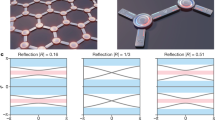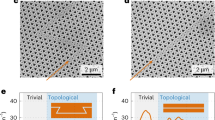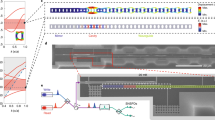Abstract
Topological insulators were originally discovered for electron waves in condensed-matter systems. Recently, this concept has been transferred to bosonic systems such as photons1 and phonons2, which propagate in materials patterned with artificial lattices that emulate spin-Hall physics. This work has been motivated, in part, by the prospect of topologically protected transport along edge channels in on-chip circuits2,3. In principle, topology protects propagation against backscattering, but not against loss, which has remained limited to the dB cm−1 level for phononic waveguides, whether topological4,5,6,7 or not8,9,10,11,12,13,14,15,16,17,18,19. Here we combine advanced dissipation engineering20—in particular, the recently introduced method of soft clamping21—with the concept of valley-Hall topological insulators for phonons22,23,24,25,26. This enables on-chip phononic waveguides with propagation losses due to dissipation of 3 dB km−1 at room temperature, orders of magnitude below any previous chip-scale devices. The low losses also allow us to accurately quantify backscattering protection in topological phononic waveguides, using high-resolution ultrasound spectroscopy. We infer that phonons follow a sharp, 120° bend with a 99.99% probability instead of being scattered back, and less than one phonon in a million is lost. Our work will inspire new research directions on ultralow-loss phononic waveguides and will provide a clean bosonic system for investigating topological protection and non-Hermitian topological physics.
This is a preview of subscription content, access via your institution
Access options
Access Nature and 54 other Nature Portfolio journals
Get Nature+, our best-value online-access subscription
$32.99 / 30 days
cancel any time
Subscribe to this journal
Receive 51 print issues and online access
$199.00 per year
only $3.90 per issue
Buy this article
- Purchase on SpringerLink
- Instant access to full article PDF
Prices may be subject to local taxes which are calculated during checkout





Similar content being viewed by others
Data availability
The data that support the findings of this study in the main text and the Supplementary Information are available at Zenodo53 (https://doi.org/10.5281/zenodo.15183532).
Code availability
The codes that support the findings of this study are available at Zenodo53 (https://doi.org/10.5281/zenodo.15183532).
References
Ozawa, T. et al. Topological photonics. Rev. Mod. Phys. 91, 015006 (2019).
Shah, T., Brendel, C., Peano, V. & Marquardt, F. Colloquium: topologically protected transport in engineered mechanical systems. Rev. Mod. Phys. 96, 021002 (2024).
Hafezi, M., Demler, E. A., Lukin, M. D. & Taylor, J. M. Robust optical delay lines with topological protection. Nat. Phys. 7, 907–912 (2011).
Cha, J., Kim, K. W. & Daraio, C. Experimental realization of on-chip topological nanoelectromechanical metamaterials. Nature 564, 229–233 (2018).
Yu, S.-Y. et al. Critical couplings in topological-insulator waveguide-resonator systems observed in elastic waves. Natl Sci. Rev. 8, nwaa262 (2020).
Xi, X., Ma, J., Wan, S., Dong, C.-H. & Sun, X. Observation of chiral edge states in gapped nanomechanical graphene. Sci. Adv. 7, eabe1398 (2021).
Hatanaka, D. et al. Valley pseudospin polarized evanescent coupling between microwave ring resonator and waveguide in phononic topological insulators. Nano Lett. 24, 5570–5577 (2024).
Hatanaka, D., Mahboob, I., Onomitsu, K. & Yamaguchi, H. Phonon waveguides for electromechanical circuits. Nat. Nanotechnol. 9, 520–524 (2014).
Hatanaka, D., Dodel, A., Mahboob, I., Onomitsu, K. & Yamaguchi, H. Phonon propagation dynamics in band-engineered one-dimensional phononic crystal waveguides. New J. Phys. 17, 113032 (2015).
Cha, J. & Daraio, C. Electrical tuning of elastic wave propagation in nanomechanical lattices at MHz frequencies. Nat. Nanotechnol. 13, 1016–1020 (2018).
Fu, W. et al. Phononic integrated circuitry and spin-orbit interaction of phonons. Nat. Commun. 10, 2743 (2019).
Patel, R. N. et al. Single-mode phononic wire. Phys. Rev. Lett. 121, 040501 (2018).
Romero, E. et al. Propagation and imaging of mechanical waves in a highly stressed single-mode acoustic waveguide. Phys. Rev. Appl. 11, 064035 (2019).
Mayor, F. M. et al. Gigahertz phononic integrated circuits on thin-film lithium niobate on sapphire. Phys. Rev. Appl. 15, 014039 (2021).
Xu, X.-B. et al. High-frequency traveling-wave phononic cavity with sub-micron wavelength. Appl. Phys. Lett. 120, 163503 (2022).
Feng, Z., Liu, Y., Xi, X., Wang, L. & Sun, X. Gigahertz phononic integrated circuits based on overlay slot waveguides. Phys. Rev. Appl. 19, 064076 (2023).
Chen, I.-T. et al. Optomechanical ring resonator for efficient microwave-optical frequency conversion. Nat. Commun. 14, 7594 (2023).
Zhang, L., Cui, C., Chen, P.-K. & Fan, L. Integrated-waveguide-based acousto-optic modulation with complete optical conversion. Optica 11, 184–189 (2024).
Bicer, M. & Balram, K. C. Low-loss GHz frequency phononic integrated circuits in gallium nitride for compact radio frequency acoustic wave devices. IEEE Trans. Ultrason. Ferroelectr. Freq. Control 71, 172–181 (2024).
Engelsen, N. J., Beccari, A. & Kippenberg, T. J. Ultrahigh-quality-factor micro- and nanomechanical resonators using dissipation dilution. Nat. Nanotechnol. 19, 725–737 (2024).
Tsaturyan, Y., Barg, A., Polzik, E. S. & Schliesser, A. Ultracoherent nanomechanical resonators via soft clamping and dissipation dilution. Nat. Nanotechnol. 12, 776–783 (2017).
Lu, J. et al. Observation of topological valley transport of sound in sonic crystals. Nat. Phys. 13, 369–374 (2017).
Yan, M. et al. On-chip valley topological materials for elastic wave manipulation. Nat. Mater. 17, 993–998 (2018).
Ma, J., Xi, X. & Sun, X. Experimental demonstration of dual-band nano-electromechanical valley-hall topological metamaterials. Adv. Mater. 33, 2006521 (2021).
Zhang, Q. et al. Gigahertz topological valley Hall effect in nanoelectromechanical phononic crystals. Nat. Electron. 5, 157–163 (2022).
Ren, H. et al. Topological phonon transport in an optomechanical system. Nat. Commun. 13, 3476 (2022).
Eggleton, B. J., Poulton, C. G., Rakich, P. T., Steel, M. J. & Bahl, G. Brillouin integrated photonics. Nat. Photon. 13, 664–677 (2019).
Safavi-Naeini, A. H., van Thourhout, D., Baets, R. & Laer, R.van Controlling phonons and photons at the wavelength scale: integrated photonics meets integrated phononics. Optica 6, 213–232 (2019).
Fang, K., Matheny, M. H., Luan, X. & Painter, O. Optical transduction and routing of microwave phonons in cavity-optomechanical circuits. Nat. Photon. 10, 489–496 (2016).
Zivari, A., Stockill, R., Fiaschi, N. & Gröblacher, S. Non-classical mechanical states guided in a phononic waveguide. Nat. Phys. 18, 789–793 (2022).
Wu, L.-H. & Hu, X. Scheme for achieving a topological photonic crystal by using dielectric material. Phys. Rev. Lett. 114, 223901 (2015).
Khanikaev, A. B. & Shvets, G. Two-dimensional topological photonics. Nat. Photon. 11, 763–773 (2017).
Barik, S. et al. A topological quantum optics interface. Science 359, 666–668 (2018).
Cupertino, A. et al. Centimeter-scale nanomechanical resonators with low dissipation. Nat. Commun. 15, 4255 (2024).
Rossi, M., Mason, D., Chen, J., Tsaturyan, Y. & Schliesser, A. Measurement-based quantum control of mechanical motion. Nature 563, 53–58 (2018).
Mason, D., Chen, J., Rossi, M., Tsaturyan, Y. & Schliesser, A. Continuous force and displacement measurement below the standard quantum limit. Nat. Phys. 15, 745–749 (2019).
Huang, G., Beccari, A., Engelsen, N. J. & Kippenberg, T. J. Room-temperature quantum optomechanics using an ultralow noise cavity. Nature 626, 512–516 (2024).
Seis, Y. et al. Ground state cooling of an ultracoherent electromechanical system. Nat. Commun. 13, 1507 (2022).
Kurpiers, P., Walter, T., Magnard, P., Salathe, Y. & Wallraff, A. Characterizing the attenuation of coaxial and rectangular microwave-frequency waveguides at cryogenic temperatures. EPJ Quantum Technol. 4, 8 (2017).
Schmid, S., Villanueva, L. G. & Roukes, M. L. Fundamentals of Nanomechanical Resonators 2nd edn (Springer, 2023).
Košata, J. & Zilberberg, O. Second-order topological modes in two-dimensional continuous media. Phys. Rev. Res. 3, L032029 (2021).
Lu, J. et al. Dirac cones in two-dimensional artificial crystals for classical waves. Phys. Rev. B 89, 134302 (2014).
Shah, T., Marquardt, F. & Peano, V. Tunneling in the Brillouin zone: theory of backscattering in valley Hall edge channels. Phys. Rev. B 104, 235431 (2021).
Villanueva, L. G. & Schmid, S. Evidence of surface loss as ubiquitous limiting damping mechanism in sin micro- and nanomechanical resonators. Phys. Rev. Lett. 113, 227201 (2014).
Rempe, G., Thomson, R. J., Kimble, H. J. & Lalezari, R. Measurement of ultralow losses in an optical interferometer. Opt. Lett. 17, 363–365 (1992).
Rosiek, C. A. et al. Observation of strong backscattering in valley-Hall photonic topological interface modes. Nat. Photon. 17, 386–392 (2023).
Rugar, D. & Grütter, P. Mechanical parametric amplification and thermomechanical noise squeezing. Phys. Rev. Lett. 67, 699–702 (1991).
Xi, X., Ma, J. & Sun, X. A topological parametric phonon oscillator. Adv. Mater. 37, 2309015 (2025).
Peano, V., Houde, M., Marquardt, F. & Clerk, A. A. Topological quantum fluctuations and traveling wave amplifiers. Phys. Rev. X 6, 041026 (2016).
Hälg, D. et al. Strong parametric coupling between two ultracoherent membrane modes. Phys. Rev. Lett. 128, 094301 (2022).
Barg, A. et al. Measuring and imaging nanomechanical motion with laser light. Appl. Phys. B 123, 8 (2017).
Mashaal, A. et al. Strong thermomechanical noise squeezing stabilized by feedback. Phys. Rev. Res. 7, L012071 (2025).
Xi, X. et al. Data and code for “A soft-clamped topological waveguide for phonons”. Zenodo https://doi.org/10.5281/zenodo.15183532 (2025).
Acknowledgements
We acknowledge T. Capelle for the help with micro-fabrication. This work was supported by the European Research Council project PHOQS (grant no. 101002179), the Novo Nordisk Foundation (grant nos. NNF20OC0061866 and NNF22OC0077964), the Danish National Research Foundation (Centre of Excellence ‘Hy-Q’), the Independent Research Fund Denmark (grant no. 1026-00345B), the Swiss National Science Foundation (CRSII5 177198/1, CRSII5 206008/1 and PP00P2 163818), the Deutsche Forschungsgemeinschaft (project nos. 449653034 and SFB1432), the Horizon 2020 research and innovation programme of the European Union (the Marie Skłodowska–Curie grant agreement no. 101107341) and a research grant (VIL59143) from the Villum Foundation.
Author information
Authors and Affiliations
Contributions
X.X. designed the devices and built the setup with contributions from I.C.; X.X. and I.C. conducted the measurements and analysed the data. J.K. and O.Z. contributed to the design at an early stage and developed the topological theory. X.X., J.K., M.B.K. and E.L. conducted the numerical simulations. X.X., M.B.K. and A.S. analysed dissipation dilution and soft clamping. E.L. fabricated the devices. A.S.S. contributed to the discussion and understanding of the experimental data. X.X., J.K. and A.S. wrote the paper with input from all the authors. X.X. and A.S. supervised the project.
Corresponding authors
Ethics declarations
Competing interests
E.L. and A.S. have co-founded the company Qfactory ApS, which commercializes soft-clamped phononic resonators. The other authors declare no competing interests.
Peer review
Peer review information
Nature thanks Jiuyang Lu and the other, anonymous, reviewer(s) for their contribution to the peer review of this work. Peer reviewer reports are available.
Additional information
Publisher’s note Springer Nature remains neutral with regard to jurisdictional claims in published maps and institutional affiliations.
Extended data figures and tables
Extended Data Fig. 1 Experimental setup.
Shown is the fiber laser (1550 nm), the two photodetectors (PD), the proportional-integral-derivative (PID) controller (FPGA: Red Pitaya), a phase shifter (θ, piezo fiber stretcher), the lock-in amplifier (lock-in), and a signal generator (SG). The membrane is simultaneously imaged with a CCD camera.
Supplementary information
Rights and permissions
Springer Nature or its licensor (e.g. a society or other partner) holds exclusive rights to this article under a publishing agreement with the author(s) or other rightsholder(s); author self-archiving of the accepted manuscript version of this article is solely governed by the terms of such publishing agreement and applicable law.
About this article
Cite this article
Xi, X., Chernobrovkin, I., Košata, J. et al. A soft-clamped topological waveguide for phonons. Nature 642, 947–953 (2025). https://doi.org/10.1038/s41586-025-09092-x
Received:
Accepted:
Published:
Issue date:
DOI: https://doi.org/10.1038/s41586-025-09092-x



